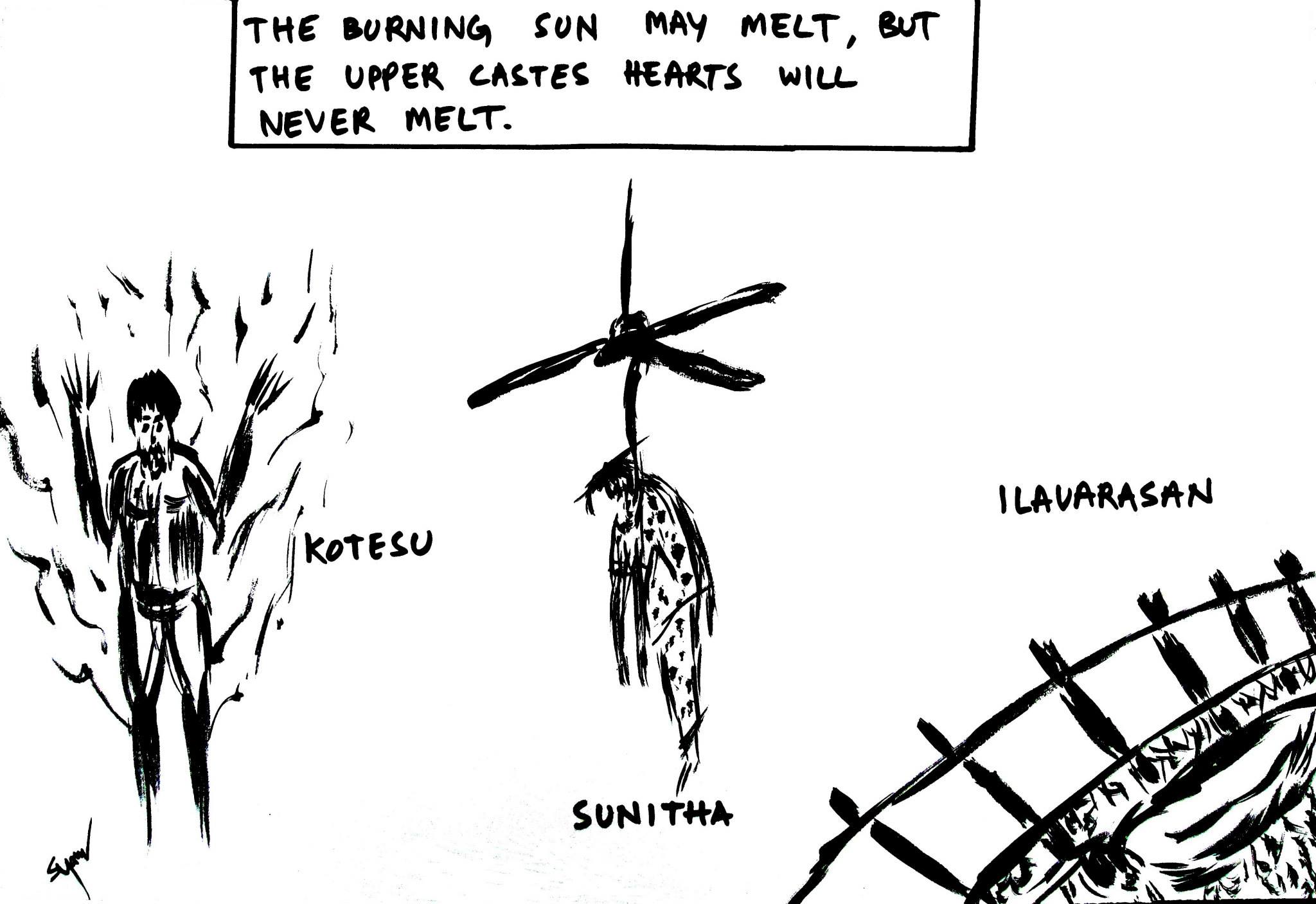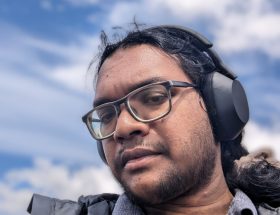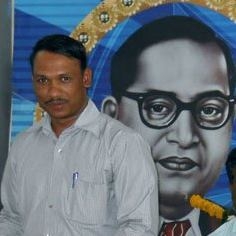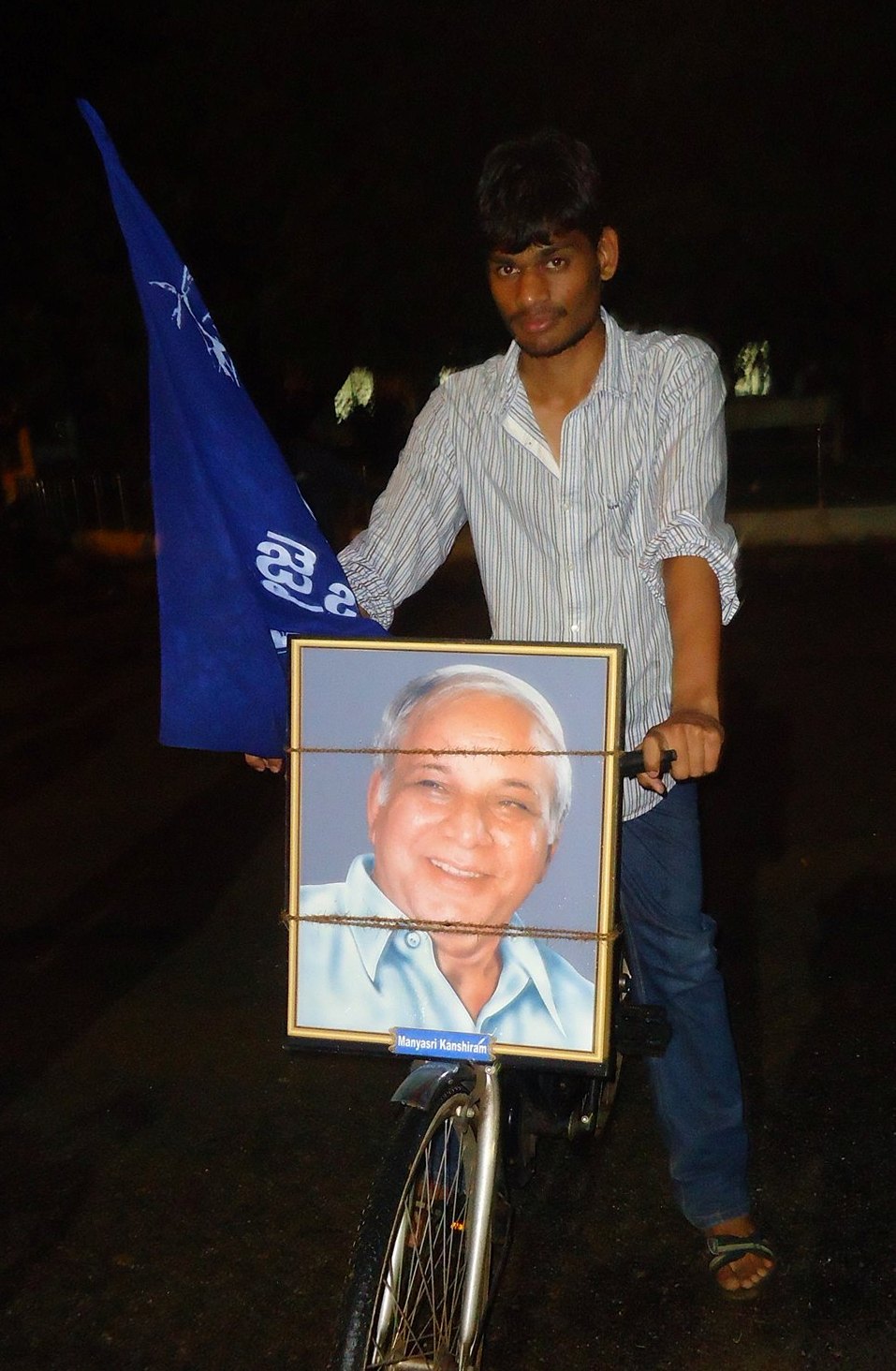Kadhiravan
~ An ideal society should be mobile, should be full of channels for conveying a change taking place in one part to other parts. In an ideal society there should be many interests consciously communicated and shared. There should be varied and free points of contact with other modes of association. In other words there should be social endosmosis. This is fraternity, which is only another name for democracy. Democracy is not merely a form of Government. It is primarily a mode of associated living, of conjoint communicated experience. It is essentially an attitude of respect and reverence towards fellow men.1 ~ Dr Babasaheb Ambedkar

Social spaces2 are political. Who we meet, dine, date, socialize in a geographical set is largely governed by the politics of who gets to be where, which in a caste-society discerns from who is born –where. A social space could be a theatre, workplace, school or college, a housing community etc. and the construction of social spaces in a caste-society is a product of the machinations of the governing class. Agraharam, Ooru, and Colony-Cheri as social spaces are products of caste system, a marker of an array of castes. As such as being the products of the caste-system, these spaces are inherently anti-social or what is indicated by Dr. Ambedkar as the absence of social-endosmosis. Corporate Board rooms, staff rooms in central universities, cafes – restaurants, malls/multiplexes correspond to the same significance of the Agraharam in reserving spaces predominantly for dominant castes. The duality of these spaces in being modern in appeal and feudal in character, democratic in letter and brahmanical in their constitution – underlies the headways Brahmanism has made during what is often dubbed as development course by the Indian state.
The history of anti-caste struggle and Reservation – not in its abstract sense of a policy measure by the ruling government, but in a concrete sense of reclaiming spaces of inequality, has posited a small yet significant section of the members of oppressed castes in certain social spaces that restricts and discourages their entry. This phenomenon has encouraged the oppressed castes at large to question dominant spaces and its relation to their marginality.
Urbanization and Capitalism could threaten the village mould of caste-system, providing new social spaces where the array of oppressed castes could organize-consolidate more as a class withdrawing from feudal-social relationships. But one does see the formation of new ghettos and ghettos within ghettos3 in urban-suburban locales indicating the deep ferment the caste-system is. It also indicates the strong-hold of Brahmanism in this society where Capitalism that could topple feudal system in Europe has been unsuccessful in replacing one form of hegemony by another. The sub-continent is rather a witness to the twin model of Capitalism and Brahmanism operating both dependent and independent of each other.
The presence of the oppressed castes in these social spaces contrives against the caste influenced division of labour and it carries an assumption that they are in an equal plane vis-à-vis the members of the brahmanical classes in these social spaces of work, leisure and education. This assumption should impel social exchanges, socializations cutting across castes – but one does find the need to forge political associations representing oppressed identities in many such spaces which reveals the conflicting nature of the original assumption. However the original assumption does not operate in a void, and there are socializations with riders and boundaries and at times breaking certain boundaries leading to inter-caste unions of different sexes of different castes.
Endogamy is symptomatic of the caste system, symptomatic of the restrictions a society could pose on the free-will and mobility of individuals. To understand the operations of endogamy and the climate where individuals could enter free-contract in matrimony and relationships is to understand the functioning of democracy in a society.
Statistics4 relating to inter-caste marriages in India are neither comprehensive nor comprehendible. The IHDS Survey-II (2014) placed a figure as miniscule as less than 5 percent to be that of marriages that involve partners from different castes against total marriages in India. The NFHS Survey (2005-06) presented a rather optimistic figure of 10 percent. However, the peculiarity of the NFHS Survey was that it reported a meager 2.59 percent in Tamil Nadu as compared to figures as high as 26.67 percent in Goa and 21.35 percent in Kerala. Tamil Nadu is a state which has a history of political churning for inter-caste marriages and successive state governments have introduced a range of schemes to promote inter-caste marriages. The paradox in these surveys could reveal how legal statutes and frameworks often stand belittled in comparison to Manu’s legality surrounding marriages in India.
“Without ado, ‘shall shoo them away,
He may be my son, but honour comes first”
Said the Gounder, who hurried inside,
Seized the lovers, who lighted the air,
Charged at them, arraigned them,
Outta his abode, Outta his sight,
“If the rogue could dare, cross the seas,
wouldn’t the rogue dare to feel,
the sunken calf’s meat?”
so, howled the Gounder.
~ Poet Tamil Oli, Excerpts “Veerayi Kaaviyam”
“Veerayi Kaaviyam” is a narrative poem written by Thamizh Oli in 1947 with Veerayi, a paraiyar woman as its protagonist who finds love in a Gounder man, marries him, only to be murdered by caste hindus.
Society’s intolerance for inter-caste union hinges on the supposed pride and control over female sexuality and has had a visibly far reaching effect of violence, brutality and ostracisation on unions involving castes – lower to lowest in the caste-hierarchy. The fate of Vimala Devi – Dileep Kumar, Gokulraj, Ilavarasan-Divya, Kannagi-Murugesan, Sankar – Kowsalysa remain to be dreadful examples. These unions speak of men and women educated – mobile who aspired and were conscious to transcend caste sanctioned norms. This is also indicative of how the original assumption does operate in a State which had witnessed greater struggles for democratization of social spaces and women’s liberation.
“It is dangerous to be an American Negro male. America has never wanted its Negroes to be men, and does not, generally, treat them as men. It treats them as mascots, pets, or things.” ~ James Baldwin
Violence that was meted to such couples also indicate the trepidation, feudal institutions are realizing over the process of democratization of social spaces – to the extent that violence as a resort post desperateness could contain. One could observe here that the control over female sexuality extends to that expressed by men from dalit communities, and that dalit men suffer patriarchy is obfuscated by the mainstream academia’s obsession over feigned terms as dalit-patriarchy5 and dalit-masculinity6.
Dr. Ambedkar’s reading of Manu in Riddles in Hinduism (RoH)7 presents a riveting analysis of inter-caste unions, and the many riddles and complexities involved therein. Manu, he observed was principally opposed to the possibility that though “a Shudra could not become a Brahmin, a Kshatriya or a Vaishya, the child of a Shudra woman could become a Vaishya if she was married to a Vaishya, a Kshatriya if she was married to a Kshatriya and even a Brahmin if she was married to a Brahmin” and hence Manu changed the law of paternity, from Pitra savarnya to Matra savarnya. As Ambedkar observes, Manu employed a number of methods to restrict mobility in a strictly endogamous system that has a hierarchical arrangement of privileges. Manu also invented a dubious origin for Chandala caste, that to be the progeny of Brahmin female and Shudra male, thereby assigning an “ignoble origin to a vast number of the people in the country leading to their social and moral degradation.” These attempts, Ambedkar observed were to match the brahmins’ desire to make/sustain the Varna system as a closed system – fixing the gaps and holes that left it open. Ambedkar also espouses that Manu could have merely codified what would have been the dominant theme of the times, and that the system could not have been ordained/given per se.
This exposition lets us understand how the society systemizes inter-caste unions and marks the progeny arising out of such unions within the fold of the Varna system. And, to politicize inter-caste marriages as a solution to the caste-system could become problematic on these counts. Even more problematic is the call for inter-caste marriages among dalit communities as an arrangement to unify/strengthen dalit movement/s. Such calls could often be located in what is to be understood as a hierarchy within dalit communities which presupposes consent from lowest to lower in that hierarchy. This presupposition of consent is hegemony. This call, obviously underscores the raging reality of antagonism or absence of social-endosmosis amongst different ‘untouchable’ communities even in a linear geographical set, and it appears to have evolved from an electoral arithmetic rather than a movement towards annihilation of caste.
Manu, or in existent terms – the society also draws for compulsory matrimony (RoH) in the form of monogamous marriages – a predicament in resolving the numerical equality between the marriageable units of two sexes within the group desirous of making itself into a Caste8. Societal pressure in compulsory matrimony often stands as an extension of the anti-social spirit of the caste system to curtail the premise of liberty, equality and fraternity. What should be the freedom of two individuals is infringed upon by multiple actors – both related and unrelated. As loveless monogamous marriages have to be supplemented by adultery and prostitution9, unfortunate dalitbahujan women are the worst affected by it as they stand to hold up for the promiscuity of the male gender, which the society though demoralizes, nevertheless allows. Marriage as a free-contract could only be realized in the absence of socio-economic considerations or in other words on annihilation of caste.
~ I am convinced that the real remedy is inter-marriage. Fusion of blood can alone create the feeling of being kith and kin, and unless this feeling of kinship, of being kindred, becomes paramount, the separatist feeling—the feeling of being aliens—created by Caste will not vanish. Among the Hindus, inter-marriage must necessarily be a factor of greater force in social life than it need be in the life of the non-Hindus. Where society is already well-knit by other ties, marriage is an ordinary incident of life. But where society is cut asunder, marriage as a binding force becomes a matter of urgent necessity. The real remedy for breaking Caste is inter-marriage. Nothing else will serve as the solvent of Caste. […]
Caste may be bad. Caste may lead to conduct so gross as to be called man’s inhumanity to man. All the same, it must be recognized that the Hindus observe Caste not because they are inhuman or wrong-headed. They observe Caste because they are deeply religious. People are not wrong in observing Caste. In my view, what is wrong is their religion, which has inculcated this notion of Caste. If this is correct, then obviously the enemy you must grapple with is not the people who observe Caste, but the Shastras which teach them this religion of Caste. Criticizing and ridiculing people for not inter-dining or inter-marrying, or occasionally holding inter-caste dinners and celebrating inter-caste marriages, is a futile method of achieving the desired end. The real remedy is to destroy the belief in the sanctity of the Shastras.10
~ Dr Babasaheb Ambedkar
Dr Ambedkar’s fight against the caste-system was multifold. He considered Hinduism as an ideology that perpetuated inequality and embraced Buddhism in 1956. Iyothee Thasar Pandithar had started the Sakya Buddhist Association11 in 1898. The Sakya Buddhist Association constructed a Buddha Vihar in 1906, which also functioned as a school for the depressed classes. The space gave rise to many Dalit leaders like Jenaraju and the Buddhist thought inspired leaders like M Singaravelu (hailed as First communist of South India) and Thanthai Periyar. The space also inspired Pokkala Lakshmi Narasu12 whose seminal work “The Essence of Buddhism” was described as the best book on Buddhism by Dr. Ambedkar. It is also said that the first self-respect general conference during the Dravidian movement took place in Kolar13 under the auspices of Sakya Buddhist Association.
Buddhism as expressed by Dr Ambedkar is what Edward Soja defines as the third space14. Dr. Ambedkar embracing Buddhism is a product of his vision to construct a space that Edward Soja would define as, “a social product that is a space created by society under oppression or marginalization that want to reclaim the space of inequality and make it into something else.” The onus to sustain and further the space is on the democratic forces, led by the oppressed communities.
A socio-political space thus procreated would negate the forced assumption of inter-caste unions as a tool towards annihilation of caste. The space could rather aid the ideals of love, compassion, co-operation and humanity that would facilitate social interactions and alliances cutting across caste-lines leading towards annihilation of caste, towards an egalitarian society.
~
References
1. BAWS Vol.I – Annihilation of Caste.
2. Refer Henri Lefebvre, Edward Soja for Sociology of Space, Spatial theory.
3. The meter of development in Brahmin dominated localities in Chennai like Mylapore, Besant Nagar, Chromepet, etc. where avenues of healthcare, education and leisure have exponentially increased on a scale that is abundant considering the population and to contrast it with what has become a routine exercise of evacuation of dalit bahujan – working class in the name of development (Eg. Semmanjeri, Kannagi Nagar) is equally symptomatic of the caste system. That the dalit-bahujan settlements have antagonism and camps based on individual castes is also a raging reality.
4. http://www.academia.edu/1265838/ Caste Class and Urbanization The Shaping of Religious Community in Contemporary India last accessed on 11.02.2017.
5. The Dharmapuri violence on Dalits prompted Anandhi S to caricature the violence as a result of competing masculinities between Vanniyars and Dalits (http://www.thehindu.com/opinion/op-ed/where-buying-a-motorcycle-can-spark-a-riot/article4280216.ece) last accessed on 11.02.2017.
6. Incidentally, V Geetha in her review of Perumal Murugan’s works upholds the treatment of dalit-bahujan male identities as mere masculine identities whose ‘relative prosperity’ would dictate the ‘love’ of bahujan women. This is eerily similar to what the PMK patriarch Ramadoss portrays as planned love-traps of smartly dressed dalit-men. Though the vulgarity of Ramadoss has been called out more often, the brahmanical academia has been largely fortified, also indicating how Brahmanism thrives and sustains hegemony in favour of the brahmanical classes (http://indianexpress.com/article/opinion/colfumns/the-silencing-of-murugan/) – last accessed on 11.02.2017.
7. BAWS, Vol. III – Riddles in Hinduism.
8. BAWS, Vol. I – Castes in India: Their Mechanism, Genesis and Development.
9. Engels. The Origin of Family, Private Property and State.
10. Same as [1]
11. Dalit Movement in India and its leaders, 1857-1956, Ramachandra Kshīrasāgara.
12. Mulnivasi Organiser: Iyothee Thass and Buddhism (http://mulnivasiorganiser.bamcef.org/?p=324) .
Also, “Decoding the Spirit of Castes: A Review of Pokala Lakshmi Narasu’s ‘A Study of Caste’ by Nidhin Shobana (http://roundtableindia.co.in/index.php?option=com_content&view=article&id=8847:decoding-the-spirit-of-castes-a-book-review-of-pokala-lakshmi-narasu-s-a-study-of-caste&catid=119:feature&Itemid=132)
13. Same as [12]
14. Same as [2]
~~~
Kadhiravan works in a public sector bank.
Illustration by Unnamati Syama Sundar, from his series ‘Untouchable love’.










